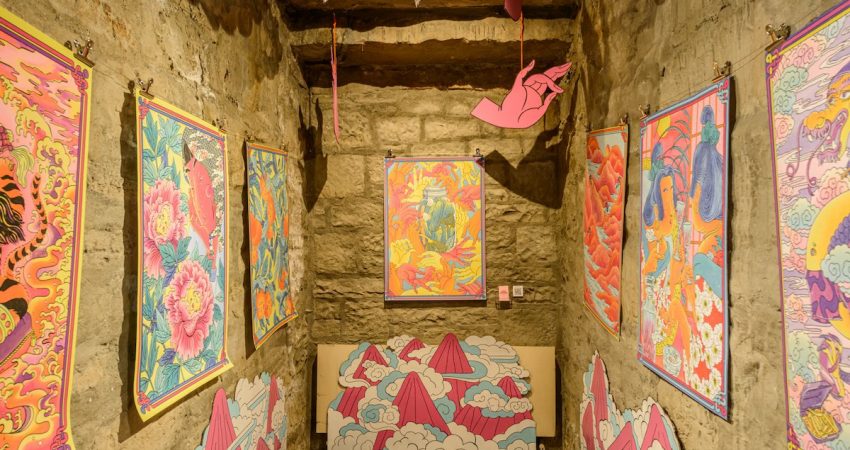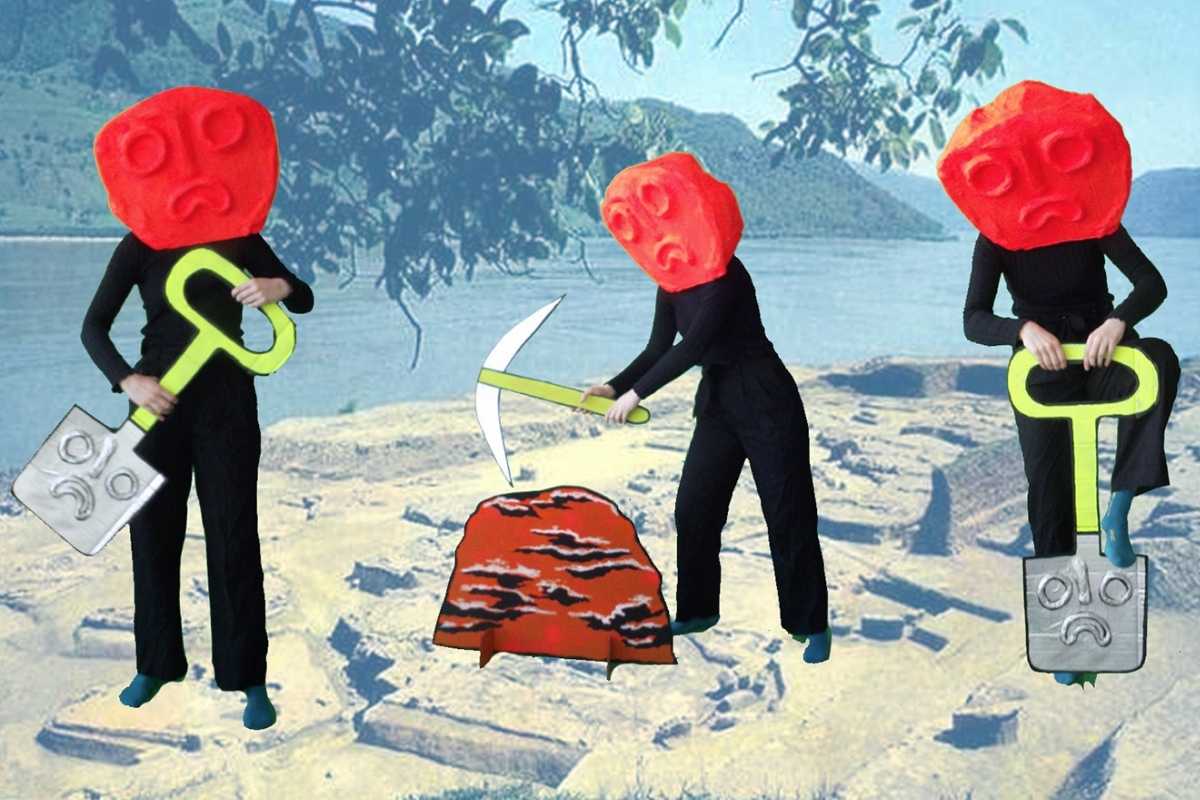

June 4, 2022
We caught up with one of our Visual Art curators, Jill Martin Boualaxai, to hear more about the process of selecting this year’s artists.
Jill Martin Boualaxai is a multimedia artist based in Edinburgh, whose practice explores themes drawing on her prior career as an archeologist. Jill has been involved in Hidden Door since the very first festival in 2014.
Tell us about the process of selecting the artists – how did you approach sorting through the applications?
We got around 160 applications through the open call, maybe more. This year there was a small selection panel of three; me, Oana Stanciu and David Martin. We individually went through all of the applicants and scored them based on various different criteria, then we met up to chat about it and to narrow it down to a shortlist. It probably took about three or four meetings to go through them until we had the final program decided, it was really tough!
On top of the people chosen through the open call, we’ve also invited back a few students and graduates who exhibited at last year’s Hidden Door, and there are some artists coming from the Leith School of Art as well, along with the Creative Collaboration projects. In an application, it’s primarily the images that draw you to it, and this year there were so many really strong images, and really exciting ideas which grabbed us, so it was hard to narrow it down!


Did you have any preconceived ideas or themes you wanted to explore, or did it emerge from the applications?
Oh yeah, it’s what came up naturally through the applications. I’ve definitely got specific things that I lean towards; I love interesting materials, I love sculpture, I love installation, so the personal tastes of the curators will inevitably play a role, but there was no set idea going into it.
What’s interesting is, if you look at the themes, there are quite a lot of pieces that are referencing ideas around archaeology, history and heritage. Within that it’s quite broad, of course, and there’s obviously other things happening within the program. But, when I was chatting to the artists, I did think it was fascinating how many of those kinds of references emerged in the program. But no, no deliberate themes, it’s all about what makes us the most excited.


How much were you factoring in how well the pieces could adapt to the venue of the Royal High School?
It’s a challenging venue to exhibit in, as there’s not a huge amount of space. But, when we were looking at the applications, it was always the ideas that we considered first and then the next step is figuring out how to make it work in the space, which is the task we’re onto now.
There are quite a few pieces which will be responding to the space, which I think will be really beautiful. Amy Harrison, for example, is creating work responding to the architectural qualities of the building. Kirsten Millar applied specifically to exhibit in a certain room because of the skylight, and her work will be again working with storytelling and archeological narratives, but definitely responding to the space. She’s making this massive sculpture, which I’ve seen as it’s in the metal workshop at ECA, it’s gonna be something like eight feet tall and absolutely stunning.


Other artists are bringing their own ideas, and then developing them to fit the space. I think generally, artists will have an idea that they want to bring to life, and then once they know where they’ll be exhibiting, part of the process is to adapt it so that it can be effective in whatever space it’s been given. The space can have a great effect on the development of the work, because it does influence the way it’s experienced by a viewer.
The program will exhibit the work of many recent art school graduates and relatively new, emerging Scottish artists. Was it important to you to give opportunities to people that may not have exhibited on this scale before?
Oh absolutely, it’s really important. Especially after the pandemic, the art school graduates of 2020/21 didn’t get a proper degree show, and I just think it’s so important for these artists to be given that chance, to make their work and show it to the public.
I’ve been doing a postgrad the last two years, and the experience of doing it online and not always being able to access the studios has been really bizarre and often quite difficult. So, I think it’s important for recent graduates who’ve been affected by that to be involved in something like Hidden Door.
It’s about more than just displaying your work to the public, it’s also about the community and making connections with other makers. I think Hidden Door’s always aimed to support new and emerging artists alongside more established artists, and for me personally, I’m really excited that we’ve kept on some of the student artists who we worked with last year. By continuing to support them and giving them these chances to exhibit, it will make a huge difference to whether they’re able to keep making work in future. Because it’s hard to be an artist and get your work seen, it can be really hard.
There’s a huge range of mediums and forms being explored in the exhibition – from paintings and sculpture to photography and light work – was this an intentional choice?
I mean, like I said, I always will be drawn to sculpture, and tactile and immersive things. But it’s not just me involved; David and Oana are bringing their own tastes too. When we were going through the applications, we were thinking a bit about finding a balance between different forms.
But, when we were going through the original projects applications, we wouldn’t have disregarded anything based on medium alone. For example, there were quite a few project applications that were dealing with the environment, coastlines, seas and pollution. In the end we decided to select the idea that we felt was addressing it using the most exciting and innovative methods. So, Evie Rose Thornton is making these explorations using handmade litmus paper, which measures PH levels in water, and she’ll be installing these large sculptural drawings in the space alongside a video piece of the works in situ along the coastline. The piece will appear calming, and really beautiful, but this false sense of calm will be interrupted with a slow and unsettling build using audio cues.
Which projects are you really excited to see come together?
Oh, this is going to be a really long list! So I’m really excited about Sax Shaw’s work, which is this huge, gorgeous stained glass window. He’s in my studio at WASPS, so I’ve seen it in development a little bit and I think that’s going to be quite glorious. He’s using an existing window in the school and installing a stained glass piece in front of it, to kind of create light refraction around the room, which will make it a really exciting space to walk into.
I think there’s a lot of works which play with light that really stand out for me, for how they’ll make audiences feel when moving around the spaces. Maria Vigers is also doing something similar with a window, at the bottom of one of the large staircases, but she’s using omnifluorescence, and building something a bit more structure which will shed a lot of light on the stairwell.


So, for a long time now, whenever I seem to paint everything becomes green, after a bit. One of our artists, Becky Tucker, is making this “green room”, which kind of feels like peeking into my brain. I think it’ll be stunning, and she’s going to make these unique ceramic pieces and bathe the room in emerald light.
In terms of the archeological themes I mentioned earlier, there’s Emily Weaver who’s looking at the story of the Lepenski Vir fish people, exploring archaeological and anthropological objects through a video piece. Zoe Gibson is also making a silent film in which she’ll be storytelling through gesture, and she’s made these amazing papier mache costumes and props which will be seen both in the film and displayed alongside the work, I think it’s going to be really interesting.


Camilla Hanney is installing this dust rug, where she’s using stencils to create these patterns on the floor using ash and various kinds of dirt and dust. I’m slightly terrified about it, because it’s so fragile, but I do think it’ll be really beautiful and I’m so glad that it’s being included. I’ve put it in the back of a room that’s the least drafty I hope! Tess Eden Glenn’s going to be in the same room, and she’s creating this imaginative narrative of the history of a fictional student of the Royal High School, through lots of little illustrations and stories.


Miriam Mallelieu will be using those gate houses on the outside of the building, which is a really unusual and beautiful space. She’s exhibited with Hidden Door quite a few times in the past, and I’m really excited to see what she does at that space; she works with sculpture and forms, and I really think she’ll do something beautiful.
In the outer pavilion buildings you will find the work of Fraser MacBeath, an immersive film and soundscape exploring cultural and population decline in the outer Hebrides. The film will showcase some of the abandoned buildings which punctuate the landscape, alongside a number of props taken from these spaces.


There are 33 artists in the program overall and I’m devastated to not be able to mention each and every project in more detail, but I’m so excited to see the whole show come together. The works will be spaced in pockets through the whole site, and it’ll be an opportunity for audience members to explore the space on their own, and discover where we’ve hidden the work.
I think it’s gonna be an amazing program, and it’s great that audiences can come and experience it at different times of the day and in different contexts.
Above all, I’m just happy to be able to give all these incredible artists a home for their work, finally!